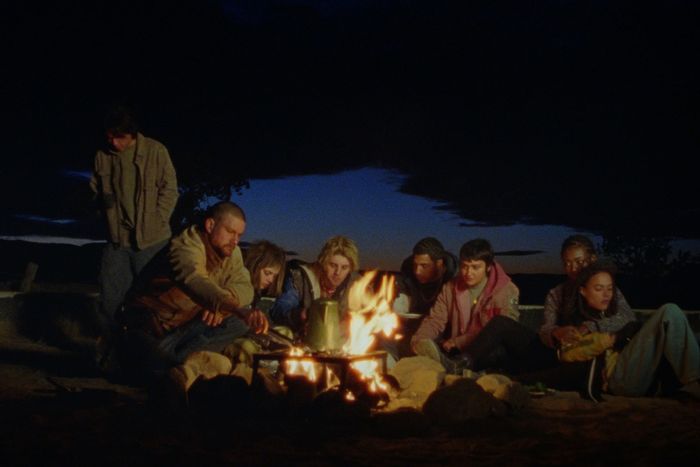
How to Blow Up a Pipeline turns a manifesto into a thriller. The film, now in theaters, is based on a book by Swedish climate activist Andreas Malm. In it, the author asserts that climate change poses an existential threat to every human being on Earth. Global governments have proven through their inaction that they will not meaningfully address this crisis. Therefore, forcing change and ensuring the survival of our species through disruption of the fossil-fuel economy is justifiable self-defense.
These ideas are baked into the movie adaptation of How to Blow Up a Pipeline, especially in conversations between the characters. Shot in 16-mm. in the deserts of west Texas, the film takes Malm’s call to action and builds it into a heist movie, with an urgency befitting the highly volatile explosive device at the center of its narrative. The characters were invented for this film, but their politics are translated faithfully from Malm’s book.
The movie was scripted by an academic (Jordan Sjol), an actor (Ariela Barer, who also stars), and its director (Daniel Goldhaber), with the film’s editor, Daniel Garber, also serving as an informal adviser. (They all share a “Film By” credit.) As with the ragtag group of radicals in their film, each brought their expertise to pull off a job that no one thought was possible. Shot in seven months with financing secured by the filmmakers themselves, the process behind How to Blow Up A Pipeline was as electrifying as the film itself. Goldhaber talked us through it.
I’m going to start with an obvious statement, which is that this is not a conventional book-to-film adaptation.
That’s interesting, because for me it doesn’t feel that different. When you’re doing an adaptation, the first thing that you start thinking about is, What is the soul of this thing, and how do I translate it from one medium to another? Pipeline is no different.
The problem with climate change is that there is no one target. You can’t pin it on one government, one corporation, one person, one system. We all participate in climate disruption, to a greater or lesser degree. Part of what is so exciting and interesting about the book is that Malm identifies a target — and a justifiable target — in fossil-fuel infrastructure.
Fossil-fuel infrastructure itself being the villain of the movie is not only an extraordinarily incisive and exciting political idea, but it’s also a great bad guy. It’s a great target for a heist. So despite the fact that the plot of the film was invented by us, the soul of the movie was born from the subject matter of the book — and the title, which by itself supposes a really exciting genre picture.
The actual story is that me and Jordan and Ariela were podded up during December 2020, just vibing and talking about stuff we were interested in. I had met Ariela for another project that had fallen apart, and we had really wanted to work together. And Jordan is an academic — he’s getting his Ph.D. at Duke. He defends his dissertation in a week.
Congrats to him. What’s it about?
His dissertation is about the rise of algorithmic finance in the 1980s written from a new-media theory perspective. I haven’t read it — even if I had, I wouldn’t be able to understand it. [Laughs.]
Anyway, Jordan had always joked, half-seriously, “There’s a lot of IP out there that hasn’t been adapted. It’s called academic theory.” And he had recommended the book to me for another project that we were working on. I got halfway through and had this lightbulb moment. I saw this image of a bunch of kids struggling in the desert with a bomb. I looked up and was like, “I think I have the thing that we can work on together.”
So the three of us teamed up, got Andreas onboard, and then did about two months of research. We interviewed activists, bomb experts, pipeline experts — anyone who could answer these questions: Who are the kinds of people that would do something like this? Why would they do something like this? And then how do you blow up a pipeline? Because the book doesn’t actually tell you.
Whenever I’m digging into a world that is not my own, I try to go in with no preconceived notions. I wanted to go into every conversation saying, “I’m thinking about making a movie in which a bunch of kids blow up a pipeline. What do you think that movie should be?” Because I think that often when people work with consultants or with real-life subjects, they go in looking for somebody to sign off on what they’re already doing.
Ariela was very much the one who built the ensemble and wrote those first five, ten pages of the script. That set the stage for the tone and the rhythm. Once we had that opening sequence, we really knew that we had something.
Throughout that entire process we were talking with Dan Garber. I went to school with Dan, we’ve been working together for almost 15 years, so he’s also a cornerstone of my process. He was offering ideas and helping us sort through our research, even just casually.
Were you incorporating ideas and talking points from the book directly, or was that coming more from the research process you’re talking about?
When I first read the book, we were in a place of almost a year of COVID lockdown, and I was in a place personally of being extremely angry and upset and feeling very powerless. The BLM protests. Massive forest fires in L.A. Massive institutional instability and failure. And then January 6, the failed insurrection.
So when we started on the project, I said, “I want to make a piece of propaganda.” And Jordan and Ariela were like, “Let’s explore that feeling, and then let’s bake that feeling into the movie, but let’s not let that anger define the film.” That wouldn’t be a particularly productive film in terms of the cultural conversations we need to have about the ideas in the book. The movie expresses that anger, but it has a much bigger perspective on the dialogue and the debate around these questions.
By the time that we presented the project to Andreas, we were very upfront about, “To be a good movie, you need conflict. You need characters that have different perspectives, and we want to engage in the criticism of the book as much as we’re engaging in the ideas themselves.”
Right.
And Andreas’s response was to send us a bunch of his favorite criticisms of the book that he thought would be productive for us. You don’t write a manifesto not expecting people to take issue with it.
Not if you’re approaching it with any kind of seriousness, no.
He also understood that the movie and the book are very different things. The way the movie will exist in the culture will be very different from the way the book exists in the culture.
How so?
The book is a verso book. It’s for a particular audience that engages with ideas in a particular way. The movie is a pop object. And that’s great, because part of the political idea behind the film is this is a conversation that we need to have on a societal level. There are things that activists are facing, like in Atlanta right now, that people are not aware of. They’re not really engaged with these massive human-rights abuses.
And so, from our perspective, part of the point of the movie is getting inside of that activist’s head. If there is a legacy of sabotage and disruption of polite society that goes hand in hand with basically every social-justice movement in history, what tactics are going to be necessary to fight climate change? You can’t provoke that conversation inside of the contemporary media ecosystem without engaging in pop.
Take a movie like Top Gun: Maverick, for instance. This is an extraordinarily jingoistic, pro-violence, pro-military film. That is a film that promotes death and destruction. This is something that is extraordinarily common in mainstream Hollywood filmmaking, but we don’t treat those films as dangerous movies or provocative films because we embrace that as part of the mainstream.
Sure. It reinforces the ruling paradigm. So we don’t read it as propaganda necessarily.
Exactly. So part of the purpose of taking this film and engaging with the language of action cinema, with the language of parallel cutting, with the language of heist filmmaking — making it familiar — is something that’s about more than just getting attention. It’s about actually saying, “There’s this idea that currently only exists on the fringes, let’s bring it into the mainstream and digest it as a culture.”
Let’s talk about the characters for a minute. Each of them takes a different path into radical political action: You have people whose lives have already been deeply affected by environmental disasters. You have radicalized college students, you have thrill-seekers — all these different types coming together. Were you consciously attempting to draw in different aspects of the movement through these characters?
Yes. I think it’s important to say that we didn’t go into the process saying, “We’re trying to check a lot of boxes.” But when you do something like this, you want to feel like you’re listening to everybody, and we wanted the movie to be a cross-section of what’s happening in the contemporary American climate movement.
I also think that’s what’s great about a heist film is it naturally suggests a ragtag group of characters, each of whom have their own specific ability and specific reason for doing this. And so applying that convention to the political ideology that goes into the film played not only into what we were trying to do from a genre perspective, but also from a rhetorical perspective.
How did the political ideology of Pipeline affect you as a director, specifically in terms of the look and tone of the film?
For me, the purpose of the movie was that it felt like it was actually happening. Why do we open the film showing you how the bombs are made? It’s all about saying, “This is something that can be done. This is something that is feasible, that is accessible, and that doesn’t cost too much money.” Once you actually see how tangible an act it is, that gets the gears of your brain churning. That’s a high-stakes idea in its own right.
So we wanted a film that would feel grounded and realistic and participatory, but that would also be fun and thrilling and kinetic. It was really always about balancing the documentary aspects with the genre aspects. One of the big things that cinematographer Tehillah De Castro and I were always juggling in the shot-list process was, How do we shoot this so it doesn’t feel like we are editorializing the act too much while still being thrilling?
This is actually an idea Ariela brought to the table. When it’s on a Steadicam, that’s when everything is going according to plan. And then when it goes handheld, that’s when things are going wrong. People think that the movie has a lot more handheld cinematography than it does, but by and large, everything is going according to plan. That was a way of empathetically connecting with the characters that also gave us possibilities to change up the language and make certain scenes more exciting.
That’s also why we shot on film. If you shoot on digital and you have this many daytime exteriors, you’re going to have to grade the movie to get it to look decent. And then all of a sudden it becomes fraudulent. It’s gonna look like a Levi’s ad. An image that feels a lot more direct and contains a natural, youthful vibrancy? That’s inherent to shooting 16-mm. out in the sun in the desert for 15 days.
Speaking of exterior photography and the desert, why west Texas? Was that a strategic or a practical decision?
I think this line is in the film, and it is true: There are these refineries and oil depots in Oklahoma and in west Texas that are essentially used to set national, international oil-price benchmarks. And if you were to substantially disrupt the supply to those refineries in particular, it could hypothetically destabilize the global oil market to such an extent that oil becomes uninsurable. There is some political theory around the idea that making oil uninsurable is a way to essentially force a move from a market standpoint.
There are 200,000 miles of active liquid petroleum pipeline in the continental United States, and most of it is unprotectable. The setting is partially about forcing a reckoning with that idea as well.
There’s an example in the book of something like this that happened in Saudi Arabia, where rebels attacked a processing facility and stopped half the country’s oil production in one go. Were you looking at these international movements that Malm talks about in the book as well?
A little bit. But we were pretty careful with the film. It’s an American film from an American perspective. It’s a piece of wish fulfillment, because nothing of this scale has actually taken place in the continental United States. So while there’s obviously quite a bit of historical precedent that informs the sabotage of fossil-fuel infrastructure, we tried to stay in that fantastical place as much as possible because it felt like the most honest thing to do.
Another dumb example is that nobody associated with the project has read The Monkey Wrench Gang. We all purposefully didn’t read The Monkey Wrench Gang because we wanted this to be coming from a place that was immediately honest to us, and to the people that we were talking to who actually have lived experiences within this movement. I imagine there are some crossovers, but I legitimately don’t know what they are.
Another book I thought about watching this film was Steal This Book by Abbie Hoffman, which is a how-to guide with detailed instructions on how to make Molotov cocktails and things like that. You have these procedural bomb-building scenes in the movie — did you have a similar intent there?
All of the steps in the movie are accurate — the measurements, the tools, what goes into making these bombs. These bombs are essentially three-stage bombs: You have the bulk explosive, the intermediate explosive, which are those PVC pipes that Michael swaps out, and then the blasting cap that triggers the whole thing.
In the film, we show you how the bulk explosive is made, and how the blasting caps are made. The intermediate explosive-making is a much more laborious process; that’s actually something, if you notice, that Michael brings with him from North Dakota. Otherwise, we show you all the steps that would go into doing this. But it’s not intended to be instructional, so much as it’s intended to demonstrate the accessibility. The point is provocation, not inspiration. It’s not a recipe.
The point is to say, if eight people could, on their own, with something like $700 worth of material, build two bombs and strategically destroy two sections of oil pipeline in such a way that it could significantly destabilize the global oil marketplace, what does that say about the tactics currently being employed by the climate movement? Part of what makes that question provocative is the immediate tangibility of how easy it is to build bombs.
That’s something that comes through in the book, too: All things considered, it’s surprising that we don’t see acts of sabotage on, say, SUVs all the time.
I think that the problem is that it’s just not reported on. There was a sabotage of the Dakota Access Pipeline, by Jessica Reznicek and Ruby Montoya. They essentially just poked holes in it with an oxy-acetylene torch. They eventually turned themselves in, and read an extremely moving confession note at a press conference. And despite the fact that that was a simple act of vandalism that caused no environmental damage, they were both arrested and charged with terrorism. Jessica was given eight years and Ruby was given six years in federal prison. That’s crazy.
There have been acts of sabotage, but the problem is that they’re not getting attention. And even when they do, there isn’t really significant coverage, which is something else that the movie is trying to solve for. It’s something that Xochitl talks about: “It has to be two bombs, because two bombs are undeniable.”
You talked earlier about anger, and putting your anger into the film. But something that I also see, both in the book and in the movie, is an element of hope.
I think it is an inherently hopeful provocation. There’s so much doomism. There’s such a belief that nothing can be done. Again, I don’t see this as a film that’s going to get people to go out there and blow up oil pipelines. That’s not really the goal. The goal is when I see people walking out of the theater feeling positive or feeling hopeful. Once you recognize that there’s something to be done, it opens up a whole world of possibilities and other ways to engage in systemic disruption, to fight climate change, to fight the fossil-fuel industry.
Ocean’s 11 is very hopeful, as a structural comp. That’s a movie where they get away with it. Another place where the movie is inherently hopeful is in the dramatic structure, where you think that they’re about to not get away with it, and then there’s a big twist and they get away with it. And that’s really exciting to me, because whenever you see stories about leftism or progressivism or activism, they tend to be stories of tragedy, especially in recent years. Look at movies like First Reformed or Night Moves.
This is a story about a group that sees past their differences to accomplish a radical — and in their eyes, justifiable — action. And it works. I hope that people are able to take that feeling out of the film and apply that to the work that they’re actually doing.
With regard to the movies about activists that have tragic endings — do you think that’s the dominant paradigm asserting itself? Like, “Don’t try this, you won’t succeed?”
I’m represented at CAA. CAA ostensibly represents this film. They sent it out to their financier list, and we did not book a single pitch meeting for this movie.
Wow.
And at almost every single Q&A, some member of the audience has asked me how we got the movie made. This is a film that really connects with audiences, but there’s also a belief that this is a movie that nobody would finance, because everybody kind of knows who pays for movies.
I am extraordinarily grateful to our financers for taking a shot on this film. But I also think it’s meaningful that we had to secure that financing ourselves, and then we were the only movie to sell during the festival at Toronto in 2022. That says a lot about where quote-unquote “independent” film finance is right now. I don’t think that there are movies being made for a lot of audiences right now, because there is a dominant cultural narrative that’s being pushed. And I think it’s really important to fight against that.
This interview has been condensed and edited for clarity.






